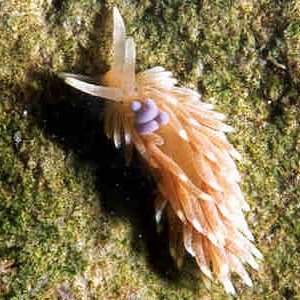
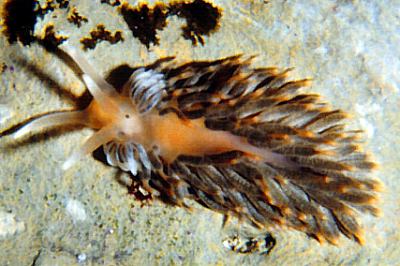
Aeolidiella alderi
(Cocks, 1852)
Order: NUDIBRANCHIA
Suborder: AEOLIDINA
Family: Aeolidiidae
DISTRIBUTION
British Isles to Mediterranean Sea
PHOTO
UPPER: Sète, southern France, Mediterranean Sea. [Dive site : étang de Thau] Depth: 3m , Size: 1 cm. December 2000. Photo: J-P. Bielecki. (Note purple eggsacs of copepod parasite).
LOWER: Animal showing characteristic white 'ruff' or collar. Bay of Algeciras (Strait of Gibraltar, southern Spain) at 1 - 6 m. depth. Size: 15 mm. Place: Las Lajas Reef. August, 1999. Photo: Alma Sánchez
The cerata in the anterior-most row differ from the rest in having the digestive gland duct only reaching halfway up. The whitish cnidosac are consequently larger, filling the upper half of these cerata and giving the animal the appearance of having a whitish collar or "ruff". Tardy (1964) has observed that the larger nematocysts in these larger cnidosacs are fired into sea anemones to help subdue them. This species feeds exclusively on sea anemones. It is hard to diferentiate in shape and colour from A. glauca, but it has a quite different reproductive behaviour with A. glauca having planktotrophic larval development while A. alderi has direct development, with no planktonic larval stage. See Bernard Picton's message differentiating A. alderi, A. sanguinea and A. glauca.
Reference:
• Thompson, T.E. & Brown, G.H. (1984) Biology of Opisthobranch Molluscs, Vol 2 Ray Society: London.
Rudman, W.B., 2001 (February 18) Aeolidiella alderi (Cocks, 1852). [In] Sea Slug Forum. Australian Museum, Sydney. Available from http://www.seaslugforum.net/find/aeolalde
Related messages
Aeolidiella alderi from Thau, French Mediterranean
November 28, 2007
From: Dominique Horst
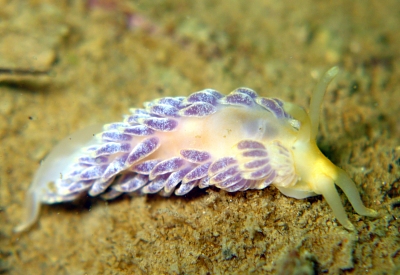
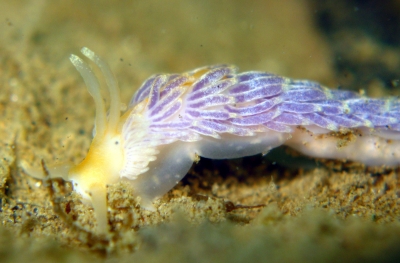
Hello Bill,
It's a long time that I planned to dive in Thau. Thau is a kind lagoon opened to the French Mediterranean in the South of France, well-known for its Sea horses and also for many species of Sea slug.
Unfortunately the water is very cold in November and it was not as crowdie as in summer.
Locality: Thau lagoon, 7 m, France, Mediterranean sea, 10 November 2007, muddy. Length: 11 mm. Photographer: Dominique Horst.
I suppose this is Aeolidiella alderi?
Many thanks for your validation.
Dom.
dominique.horst@wanadoo.fr
Horst, D., 2007 (Nov 28) Aeolidiella alderi from Thau, French Mediterranean. [Message in] Sea Slug Forum. Australian Museum, Sydney. Available from http://www.seaslugforum.net/find/21133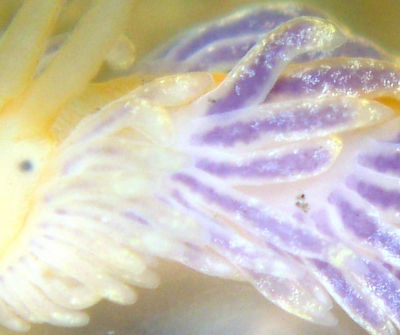
Dear Dom,
One distinguishing feature of A. alderi is that the first row of cerata on each side is white because the cnidosacs are proportionally much larger than in the other cerata which means there is little room for the digestive gland which gives each ceras its colour. I would agree with your identification
Best wishes,
Bill Rudman
Aeolidiella alderi from Croatia
July 13, 2006
From: Mat Vestjens

Hello Bill,
In June this year I took the attached picture in Selce, Croatia. I believe this must be Aeolidiella alderi, but the colour is rather pale, compaired to earlier specimens I found. Could you confirm this species or do you have a different opinion.
Locality: Selce, 5 metres, Croatia, Adriatic sea, 03-06-2006. Length: 20 mm. Photographer: Mat Vestjens
Best regards,
Mat Vestjens
annenmat@natuurlijkmooi.net
Vestjens, M.G., 2006 (Jul 13) Aeolidiella alderi from Croatia. [Message in] Sea Slug Forum. Australian Museum, Sydney. Available from http://www.seaslugforum.net/find/17098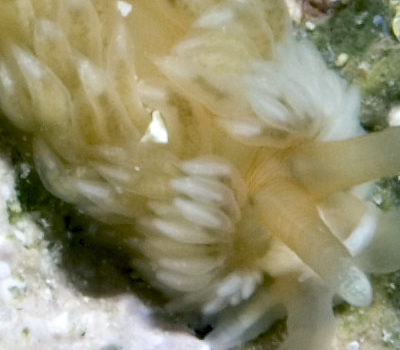
Dear Mat,
This is Aeolidiella alderi. The colour of the cerata is not a good character to use in most aeolids, because the colour of the digestive gland duct which runs up inside each ceras is dependent on the colour of the food they have been eating. Also if they have not eaten in a while, the colour can fade considerably so you get a very pale animal, as in your photo.
The best external character in A. alderi, which appears to be unique to this species, is the size of the cnidosac in the anterior row of cerata. In the close-up alongside you can clearly see that the cnidosac in each of the anterior cerata is proportionally much larger - occupying more than half the ceratal length - when compared with other cerata in the animal. Because these larger white cnidosacs replace much of the digestive gland in these anterior cerata, the cerata appear white, and make the aeolid look as though it has a white collar or 'ruff' around its neck.
Best wishes,
Bill Rudman
Aeolidiella alderi from Bembridge, UK
September 29, 2005
From: Rebecca Cooksley
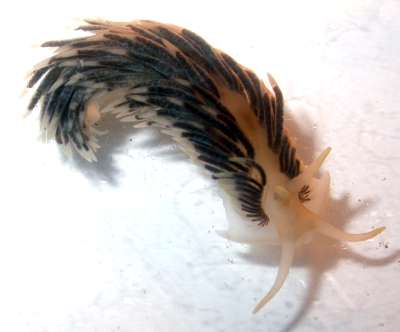
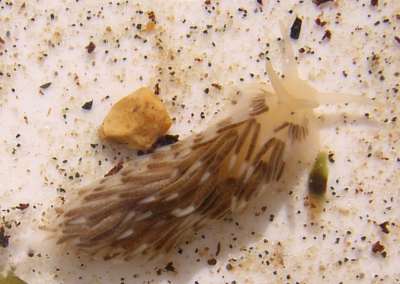
I regularly visit Bembridge rocky shore, Isle of Wight and often find sea slugs. Some have a very distinctive white ruff and so I have identified them as Aeolidiella alderi. I have also thought I found a couple of species which I initially believed to be Facelina bostoniensis, with dark cerata with white tips. However, the white tip on the first cluster of cerata sometimes extends beyond halfway down the individual cerata, only noticed on closer examination of the species. Could this species also be A.alderi? There has also been a considerable amount of variation in the colour of the cerata as well, from a dark grey to a dark yellow. The cerata do appear to extend beyond the length of the body in all those found. I know A.alderi has been found before at Bembridge, but I'm not sure if the white ruff on some of the specimens has been that distinctive and I know F.bostoniensis is often found in British waters. I attach a couple of photos of two different species, although they do not represent the variability in colour and intensity of colour.
Locality: Bembridge, Isle of Wight, UK. intertidal. Length: ~20 mm. September 2004, May/June 2005, September 2005. intertidal, limestone ledges, under boulders. Photographer: R.Cooksley, K.Marston
Many thanks for your help
P.S great website
Becky Cooksley
becky@medinavalleycentre.org.uk
Cooksley, R.C., 2005 (Sep 29) Aeolidiella alderi from Bembridge, UK. [Message in] Sea Slug Forum. Australian Museum, Sydney. Available from http://www.seaslugforum.net/find/14851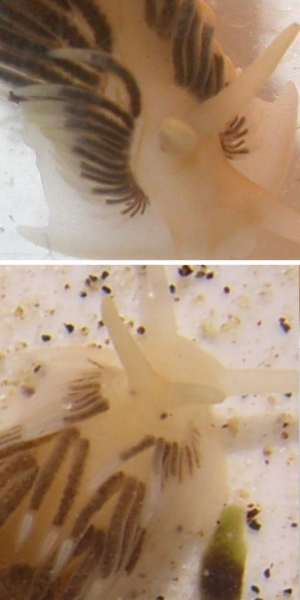
Dear Becky,
The almost complete lack of pigmentation on the skin, and the very large cnidosacs in the most anterior row of cerata are pretty good signs that both your animals are Aeolidiella alderi. Unfortunately the large cnidosacs are a bit difficult to see against the whitish foot. Have a look at Bernard Picton's discussion about Aeolidiella in UK [message #3845]. Species of Aeolidiella have the cerata arranged in many rows and their broad foot usually extends forward under the head, and in front of the cerata. In Facelina bostoniensis, the body shape is quite different, with the cerata arranged in large clumps and the head usually extending further forward than the foot. Also in that species, the rhinophores have 'annuli' or rings around them, while in Aeolidiella, they are smooth.
There is usually a range in colour in species of Aeolidiella, because they feed on variably coloured sea anemones, and the colour of the digestive gland ducts in each ceras is dependent on the colour of the food.
Best wishes,
Bill Rudman
Aeolidiella alderi from UK
August 8, 2005
From: Judith Oakley
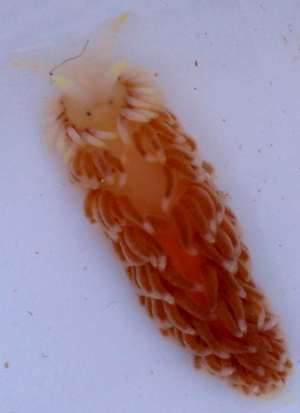
Bill,
Please can you help with identification of this sea slug. Could it be Aeolidiella sanguinea?
Locality: Dartmouth Marina, Devon, UK. Length: 7 mm. 29 June 2005. marina pontoon. Photographer: Judith Oakley
Thanks
Judith Oakley
kf1@mba.ac.uk
Oakley, J.A., 2005 (Aug 8) Aeolidiella alderi from UK. [Message in] Sea Slug Forum. Australian Museum, Sydney. Available from http://www.seaslugforum.net/find/14491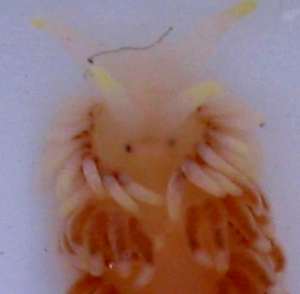
Dear Judith,
Some of these species are difficult to tell apart but when you see a specimen in which the first row of cerata are so distinctly white like this, you can be pretty sure it is Aeolidiella alderi. In this species the cnidosac is much larger in the anterior row and since it fills at least the upper half of each ceras, its translucent white colour gives the anterior cerata their white appearance. In the posterior rows, where the digestive gland duct fills much of the cerata, the ceratal colour is produced by the colour of the digestive gland instead. Best wishes,
Bill Rudman
Aeolidiella alderi from sthn England
May 13, 2005
From: Judith Oakley
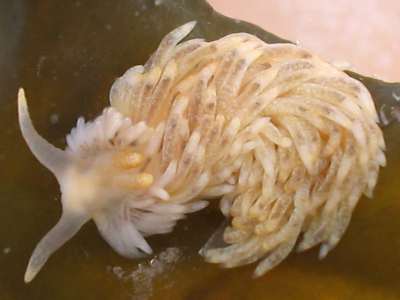
Can you have a look at these photos and let me know if this is a grey sea slug or could it possibly be Aeolidiella glauca? It doesn't seem to have the typical 'v' behind the head of the grey, and the 'fur' isn't parted down the back. It was found at Batten Bay, near Plymouth and had a yellowy/orange tinge.
Locality: Batten Bay, nr Plymouth, Devon, England. Depth: lower shore.
Length: 1 inch. 8 May 2005. Intertidal under rock. Photographer: Judith Oakley
Thank you
Judith Oakley
MarLIN
Marine Biological Association of UK and Ireland
Plymouth
kf1@mba.ac.uk
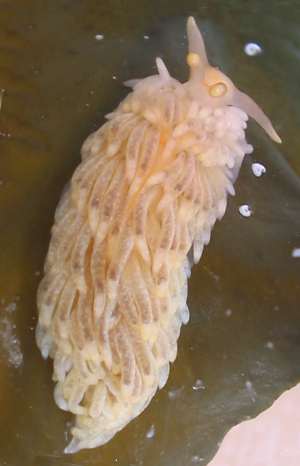
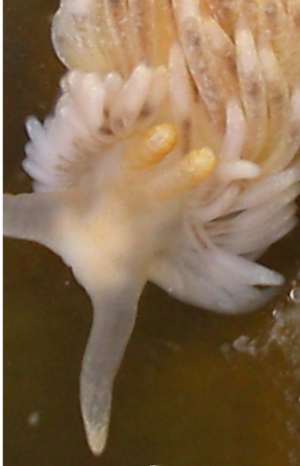
Dear Judith,
I am afraid I am not sure what you mean by a 'grey sea slug' - common names are not very universal. I am pretty sure your animal is Aeolidiella alderi. One way of distinguishing A. alderi from similarly shaped and coloured aeolid nudbranchs is that the most anterior row of cerata appear to be shorter than the other cerata and usually white. This forms what Bernard Picton [message #3845] has described as a 'ruff of white'. If you look at the close-up of the 'ruff' you can see the opaque cnidosac in these shortened cerata are much larger than usual, and occupy more than half the length of each ceras, giving them their white colouration.
A white ruff is of course a reference to the high decorative collar worn in Elizabethan times, so this is a very appropriate species to find in Plymouth, with its naval connections with Sir Francis Drake and Queen Elizabeth 1.
Best wishes,
Bill Rudman
Guernsey opisthobranch
November 20, 2003
From: Richard Lord
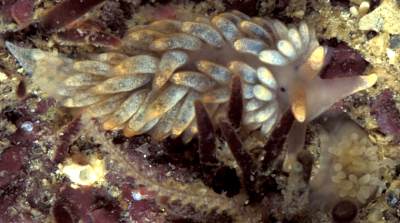
Dear Bill:
I would appreciate an identification on this little fellow. I found this 10 mm long sea slug looking like a drop of jelly on the bottom of a cobble on the lower shore at La Valette on Guernsey's east coast (Western English Channel, about 49 degrees north, 2 degrees west) on October 28, 2003.
I placed the rock underwater for photography. On development of the film I saw in a sequence of photos the nudibranch attacking the anemone, which produced acontia in defence.
I sent an email to Bernard Picton who sent the following email:
"I think this is Aeolidiella alderi, but I'm not certain. We had a pair of juveniles from Mulroy Bay in Donegal which had similar colouring. If it had small papillae on the back of the rhinophores I'd wonder if it might be the Mediterranean species Berghia coerulescens!! Try and get an adult - they are typically shore animals feeding on anemones."
He recommended that I contact the sea slug forum for help.
Richard Lord
fishinfo@guernsey.net
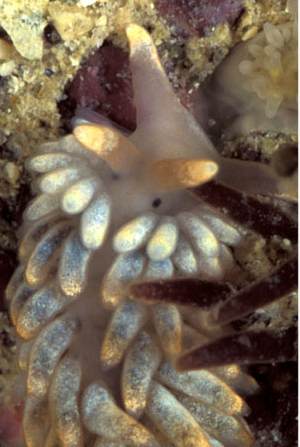
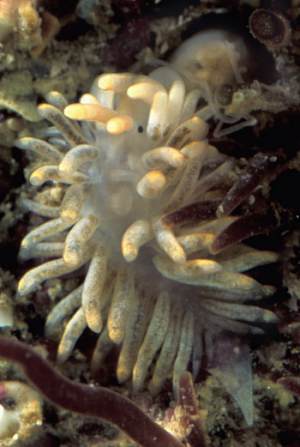
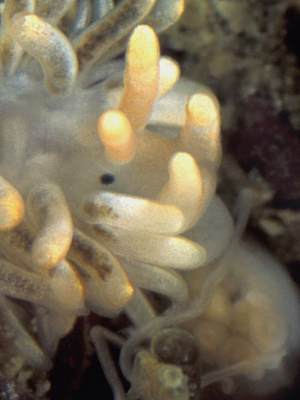
Dear Richard,
If you had sent the message directly to f anyone else has an idea please let us know. I have enlarged the head end of one of your photos as it seems to show that the digestive gland duct (brown) is much shorter in the anterior row of cerata than it is in the others. This is a characteristic feature of Aeoldiella alderi, so unless it just a trick of the light in this photo I would guess that Bernard's identification is correct
Best wishes
Bill Rudman
Aeolidiella alderi - defensive behaviour
August 25, 2003
From: Marina Poddubetskaia

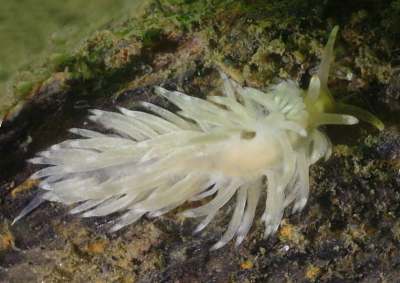
Dear Bill,
Here are the photos showing the defensive behaviour in Aeolidiella alderi - this animal bristled its cerata each time I touched it.
Date: August 16, 2003
Location: 'Le depotoir', Balaruc, Etang de Thau, France, Mediterranean coast
Depth: 6m
Size: 15mm
Photos: Marina Poddubetskaia - Nembro website
Cordially,
Marina.
nembro@nembro.info
Poddubetskaia, M. , 2003 (Aug 25) Aeolidiella alderi - defensive behaviour. [Message in] Sea Slug Forum. Australian Museum, Sydney. Available from http://www.seaslugforum.net/find/10817Thanks Marina,
Bill Rudman
Aeolidiella alderi + eggs
August 10, 2003
From: Marina Poddubetskaia
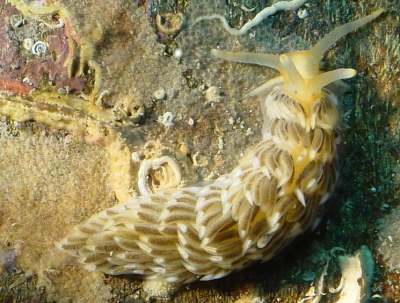
Dear Bill,
During one dive in Cerbere I turned over a rock and ... what a lovely surprise ! I saw an eolid 'sleeping' near an egg-mass. The first photo was taken at this moment.
I think this animal is Aeolidiella alderi because of its whitish collar well visible in the second photo. The egg-ribbon seems to belong to an eolid species and its large eggs fits the absence of larval stage in Aeolidiella alderi.
Moreover, the eolids hidden under rocks are uncommon in Cerbere and the only other species I saw hidden there was Facelina annulicornis. For all these reasons I assume this egg-ribbon was laid by this animal.
Date: July 13, 2003
Location: Cerbere, France, Mediterranean coast
Site: Les Chambres
Depth: 6m
Size while crawling: 25mm
Photos: Marina Poddubetskaia - Nembro website
Best wishes,
Marina.
nembro@nembro.info
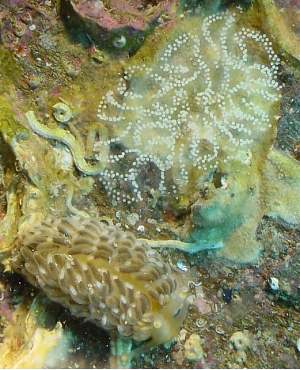
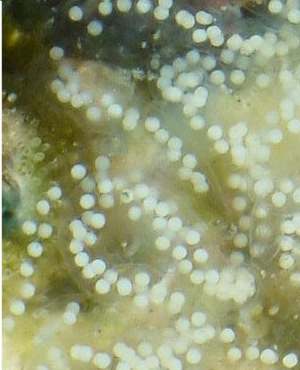
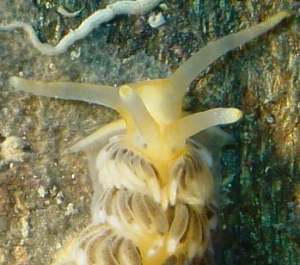
Thanks Marina,
I agree with your identification of the slug. Picton & Morrow (1994) describe the egg mass of this species as being 'a convoluted spiral thread containing large eggs' so there's a good possibility that this is its egg mass
Best wishes,
Bill Rudman
Aeolidiella alderi from Tunisia
April 22, 2003
From: Anis
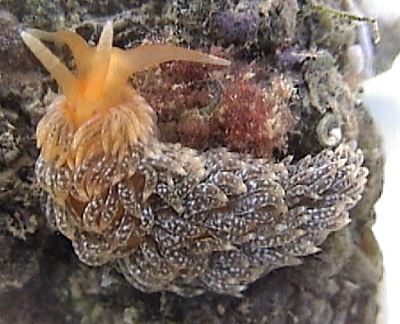
Dear Bill,
Can you identify this nudibranch from Tunisia, North Africa, please.
I found them in the coastal lagoon, Lac de Tunis, at Tunis. Depth: 0 to 1m. between January and March 2003.
Thanks,
Anis.
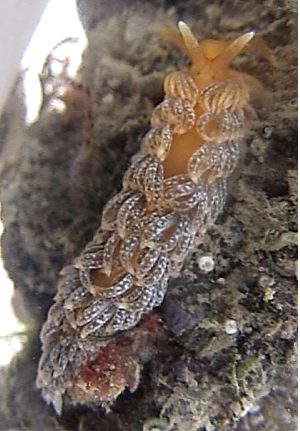
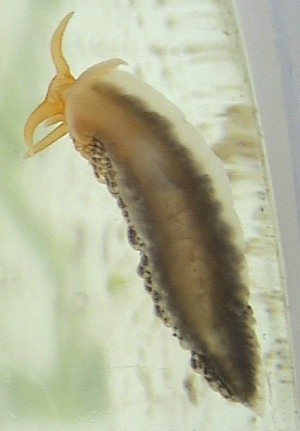
Dear Anis,
I am pretty sure this is Aeolidiella alderi but would welcome confirmation from someone with local knowledge. From Bernard Picton's message, I think the most characteristic feature of this species is the much lighter coloured cerata in the anterior rows. This is caused by the absence of the digestive gland in the upper half these cerata, replaced by a much larger cnidosac, used to sting the sea aneomes it feeds on
[As I said in reply to your earlier message, can you please send an email message to me at billr@seaslugforum.net so I have your correct email address.]
Best wishes,
Bill Rudman
Aeolidiella alderi or A. glauca
January 21, 2003
From: Mauro Doneddu
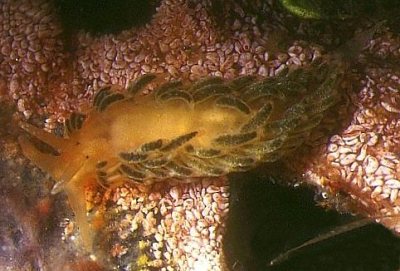
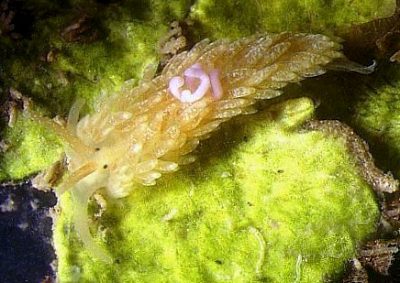
Dear Bill,
Looking for photos of colour variety of Aeolidiella alderi from Mediterranean, I re-examined all my old photos, and noted some atypical patterned specimens. They have the big eyes and the cerata pigmentation of Aeolidiella glauca, and I am doubtful between the two species. Here are enclosed 2 photos of different specimens that I sent some years ago to the Koehler's "Mediterranean Slug Site" as Aeolidiella alderi. What is your opinion?
Upper Photo:
Size: 15mm
Depth: 3m
Date: September 1993
Country: Italy, Sardinia Island
Village: Porto Istana
Divesite: Porto Legnaiuolo
Lower Photo: with parasite
Size: 18mm
Depth: 2m
Date: September 1993
Country: Italy, Sardinia Island
Village: Porto Istana
Divesite: Porto Legnaiuolo
Mauro.
maurodo@tiscali.it
Doneddu, M., 2003 (Jan 21) Aeolidiella alderi or A. glauca. [Message in] Sea Slug Forum. Australian Museum, Sydney. Available from http://www.seaslugforum.net/find/8923Dear Mauro,
I guess I should wait and let an expert from Europe comment on your photos, because as Bernard Picton says in an earlier message these species are quite tricky to distinguish externally. It seems however that A. alderi can be distinguished by an interesting feature of its most anterior cerata. Most aeolids have a cnidosac at the tip of their cerata in which they store stinging cells [nematocysts] from their cnidarian prey. A. alderi, which feeds exclusively on sea anemones, has very large cnidosacs in its most anterior cerata, for the storage of special long nematocysts, apparently useful when attacking sea anemones. Because the upper half of the anterior cerata are filled with these large cnidosacs, their dark digestive gland duct is much shorter than in the rest of the cerata, and appears as a white 'ruff' or band across the first ceratal clump on each side. You can see that clearly in Alma Sánchez's photos.
If you look carefully in both your photos, you will see that the upper half of the cerata in the first row is white, or at least lacks the darker digestive gland. From that I would suggest your animals are A. alderi. Your lower photo look very similar to Jean-Pierre Bielecki's, even down to having the same copepod parasite, as can be seen by the sausage-shaped purple egg sacs.
Best wishes,
Bill Rudman
Aeolidiella alderi from Strait of Gibraltar
January 29, 2002
From: Alma Sánchez

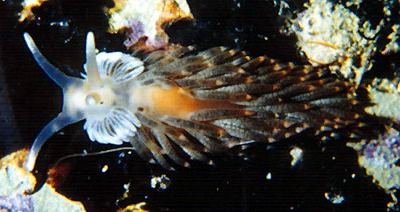
Dear Dr Rudman,
Here are two photos of Aeolidiella alderi (Cocks, 1852) showings the whitish collar in the first group of cerata.
This specimen was collected in August, 1999 at the Bay of Algeciras (Strait of Gibraltar, southern Spain) at 1 - 6 m. depth. Size: 15 mm. Place: Las Lajas Reef
Best wishes,
Alma Sánchez
almasanchez83@hotmail.com
Sánchez, A., 2002 (Jan 29) Aeolidiella alderi from Strait of Gibraltar. [Message in] Sea Slug Forum. Australian Museum, Sydney. Available from http://www.seaslugforum.net/find/6110Dear Alma,
Thanks for these photos which clearly show the white pigment on the first ceratal cluster, that Bernard Picton discussed in an earlier message.
Best wishes,
Bill Rudman
Re: Cuthona granosa ? from the Mediterranean
January 9, 2002
From: Bernard Picton
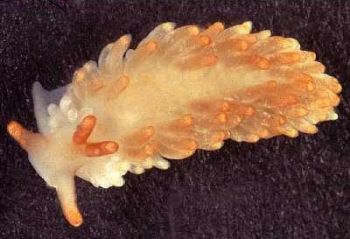
Hi Bill,
Jean-Pierre Bielecki's aeolid is believed to be a colour form of Aeolidiella alderi. I have seen it myself in Mulroy Bay, Co. Donegal, Ireland and it was found by Lemche in Co. Galway (see Just. H. & M. Edmunds, 1985. North Atlantic Nudibranchs (Mollusca) seen by Henning Lemche. p138-140). It differs from typical A. alderi in having bright orange rhinophores and some orange pigment on the cerata, but Tardy reported that there was considerable variation in the colour of this species and the orange may be derived from the diet (sea anemones). Julia Nunn, (who works here in the Ulster Museum) has also found this colour form in Mulroy Bay and reviews all records of the species in Ireland in a paper in Irish Naturalists Journal (Nunn, 1993). Julia has since seen the orange form again at Inishbofin Island, Co. Galway. It is predominantly a shore species, feeding on sea anemones beneath loose rocks.
The orange form seems only to have been reported from Ireland so it is interesting to see the exact same colour form from the Mediterranean. I've attached Julia's photo of one of the three orange specimens from Mulroy Bay, 10mm in length.
• Nunn, J., 1993. Aeolidiella alderi (Cocks, 1852) (Mollusca: Opisthobranchia) in Ireland. Irish
Naturalists Journal, 25(6): 258-260 and colour plate)
Bernard
bernard.picton.um@nics.gov.uk
Picton, B.E., 2002 (Jan 9) Re: Cuthona granosa ? from the Mediterranean. [Message in] Sea Slug Forum. Australian Museum, Sydney. Available from http://www.seaslugforum.net/find/5923Thanks Bernard,
An interesting record.
Bill Rudman
Cuthona granosa ? from the Mediterranean
December 19, 2001
From: Jean-Pierre Bielecki
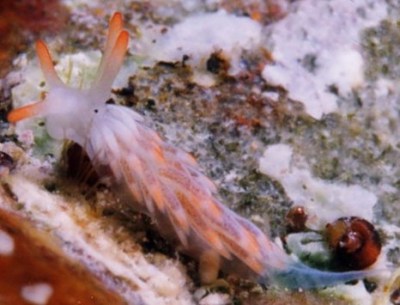
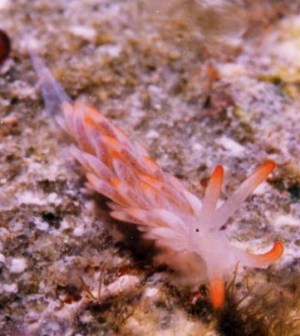
Hi Bill
Here is a photo of aeolid we suspected to be an Aeolidiella, but our French friend Géry Parent think not. He suggests a Cuthona, maybe C. granosa. We hope somebody will be able to help us to identify it through the Forum.
This animal was found in South of France [Mediterranean coast], La Ciotat, Dive Site “Canonière du Sud”, Depth 9m, size 5 mm, date July 2001.
Kind regards.
Jean Pierre
bielecki.jeanpierre@free.fr
Bielecki, J-P., 2001 (Dec 19) Cuthona granosa ? from the Mediterranean. [Message in] Sea Slug Forum. Australian Museum, Sydney. Available from http://www.seaslugforum.net/find/5802Dear Jean-Pierre,
Certainly looks a bit like C. granosa but in your animal the orange is right at the tip of the tentacles. Hopefully someone will be able to identify it for you
Best wishes,
Bill Rudman
Aeolidiella alderi
March 17, 2001
From: Jean-Pierre Bielecki
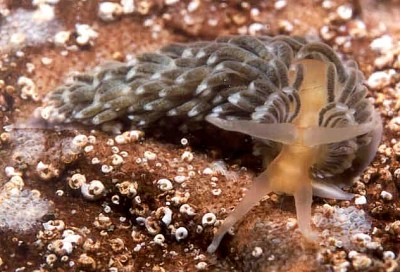
Dear Bill
As promised at the time of my last mail here are two specimens of Aeolidiella, the pale coloured one (Lower Left photos) is a typical Aeolidiella alderi, it is in conformity with the description of Bernard Picton. You will notice that it is missing an oral tentacle. I am not sure if the second animal (Upper & Lower Right photos) is a colour variety or of another species (A. glauca or A. sanguinea?).
LOWER LEFT: Dive site: îles de Lérins, Cannes, south of France, 01/10/00, 9m, Size: 8 mm, Water temperature: 21°C. UPPER & LOWER RIGHT: Dive site: Etang de Thau, Sète, south of France, 12/12/00, 6m, Size: 28 mm, Water temperature : 12°C.
Regards,
Jean-Pierre
bielecki.jeanpierre@free.fr
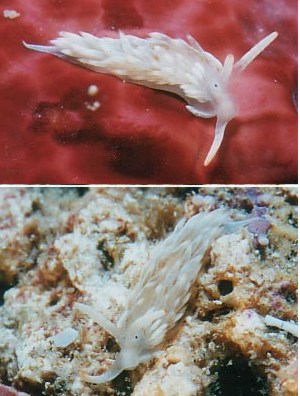
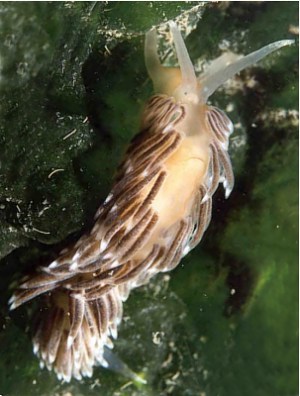
Hi Bill & Jean-Pierre,
Yes, I think these are both A. alderi. The small white one shows the elongate cnidosacs well, these are less obvious in the brown one, but the rather ragged looking cerata are more typical of A. alderi than the other Aeolidiella species here.
Bernard Picton
bernard.picton.um@nics.gov.uk
Aeolidiella alderi and parasite
February 20, 2001
From: Jean-Pierre Bielecki

Dear Bill
Here are some pictures of an aeolid I suppose to be Aeolidiella alderi found :
in Mediterraean Sea, December 2000
Dive site : étang de Thau, Sète, southern France. Depth: 3m , Size: 1 cm.
This is the first time I have seen this purple extension on its back which I suppose is its digestive gland. What is its exact function. Is it a permanent or temporary structure and is it normal?
Best regards.
Jean-Pierre
bielecki.jeanpierre@free.fr
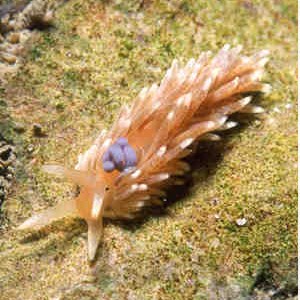
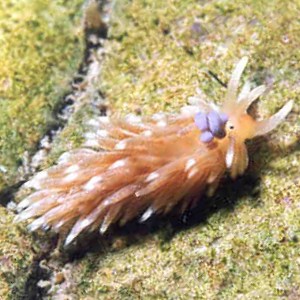
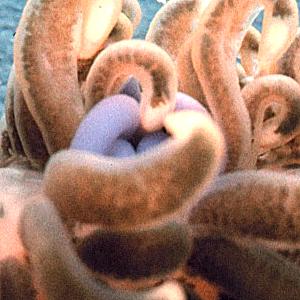
Dear Jean-Pierre,
As you will see in a separate message, Bernard Picton has confirmed this is A. alderi. The purple extensions are very interesting. They are not part of the aeolid but are the egg sacs of a crustacean parasite which is living in the body cavity of the aeolid. I am planning to put some information on the Forum concerning crustacean parasites when I get a moment.
There are a number of examples of parasites and 'commensals' already illustrated on the Forum. I have added an enlargement here [on right] of Daniel Geiger's photo of Spurilla neapolitana from Banyuls sur Mer, Mediterranean Coast, France, 1990. Four purplish white egg sacs can be seen amongst the cerata. Also have a look at the Symbiosis & Commensalism page and the Parasite page for some general information. See also the page on Ismaila, a common nudibranch parasite in South America. There are a number of photos on the Forum of egg masses protruding from aeolids in a very similar manner to the ones in your photo. There is also a photo in a message from Erwin Koehler, which also shows these egg masses in S. neapolitana from Spain.
Best wishes
Bill Rudman
Aeolidiella alderi or A. glauca
February 20, 2001
From: Bernard Picton
Hi Bill,
I think Jean-Pierre's animal is Aeolidiella alderi. These Aeolidiellas are very tricky and it's a small scan, but A. glauca always has patchy pale surface pigment on the cerata and A. alderi usually has a conspicuous ruff of white caused by the elongate cnidosacs in the first group of cerata, not apparent in this one. This individual is pink - rather pale for A. sanguinea (but if you had that parasite eating you from the inside maybe you'd be pale too!) but I'd rule out A. sanguinea as that species always has very distinct white tips to the rhinophores. The cerata are slightly straggly which seems to be more characteristic of A. alderi.
I had some lovely pictures of A. alderi sent to me recently (by post) - I'll see if the guy will send them to the Forum. The one on my website had suffered from too many days travel when I photographed it and had lost cerata at the front so the ruff is not apparent, but I don't have any other pictures.
Bernard
bernard.picton.um@nics.gov.uk
Picton , B., 2001 (Feb 20) Aeolidiella alderi or A. glauca. [Message in] Sea Slug Forum. Australian Museum, Sydney. Available from http://www.seaslugforum.net/find/3845Thanks Bernard,
I haven't been able to see any photo which shows the 'ruff' clearly so I look forward to the photos you have been sent if at all possible. Thanks also for he photos of A. sanguinea and A. glauca which I have put on the appropriate species pages.
Best wishes,
Bill Rudman
